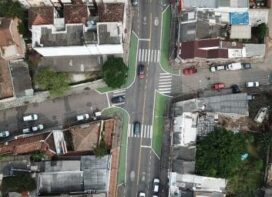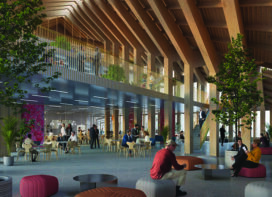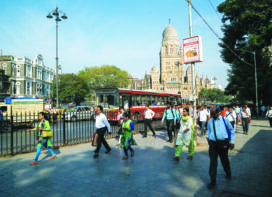An innovative proposal of a linear urban park above the railways in Mumbai by Abraham John Architects is the winner of the International Urban Planning & Urban Design Competition-Velo-City 2013, Austria.
The Mumbai based design firm principal architects, Alan Abraham & Abraham John used a combination of architectural design and geospatial tools to create a schematic design that can dramatically change the availability of and accessibility to green space in Mumbai. The city linear layout bound by water on East and West and divided by North-South rail lines experiences frequent floods during the monsoon season, which affect the rail lines, frequently shutting down rail traffic. In addition, the crossing of rail lines poses a grave danger to the commuters. To address these challenges, the project aims to turn water logging into water harvesting, reduce heat load on the railways and allow for easy and effective air conditioning.
The Concept
 Greenway proposal envisions a 21st century greenway over the existing railway lines – 114km of continuous, flat, traffic & stressfree, tree-lined shaded pathways from Churchgate to Virar, Mumbai CST to Thane, Mumbai CST to Mankhurd; with an average width of 35m. With respect to green space, this would create around 1000 acres of new urban green space in a city deprived of recreational space. The environmental impact will be overwhelmingly positive, allowing people to choose easier, healthier & faster modes of transport over energy guzzling cars. The project would carry major services: electrical, gas pipe, water supply & communication lines as well as introduces the concept of urban farming.
Greenway proposal envisions a 21st century greenway over the existing railway lines – 114km of continuous, flat, traffic & stressfree, tree-lined shaded pathways from Churchgate to Virar, Mumbai CST to Thane, Mumbai CST to Mankhurd; with an average width of 35m. With respect to green space, this would create around 1000 acres of new urban green space in a city deprived of recreational space. The environmental impact will be overwhelmingly positive, allowing people to choose easier, healthier & faster modes of transport over energy guzzling cars. The project would carry major services: electrical, gas pipe, water supply & communication lines as well as introduces the concept of urban farming.
Enhanced Connectivity
The Greenway allows for a multiplicity of uses that a modern city like Mumbai should expect from its public spaces: a vibrant linear urban park encouraging cultural and retail re-invigoration, E-W connectivity, environment restoration and a green transport & leisure solution. The garden space will be accessible at the local railway station & from anywhere else in the city. It will eliminate the East- West divide by providing connectivity and accessibility across its length. The development of the Greenway with built in retail spaces, outdoor cafes, restaurants and shopping areas will generate tourism and improve & increase the value of all the properties along the railway track. A rentable cycle scheme would allow a person to walk, cycle & use the train to his destination without owning any means of transportation but having full access to them.
The proposal strives to integrate biking, walking, leisure, the arts and entertainment holistically, while keeping people constantly in touch with nature. The Greenway beyond basic transportation needs also caters to the leisure needs of an ever-growing city.
The proposal strives to integrate biking, walking, leisure, the arts and entertainment holistically, while keeping people constantly in touch with nature. The Greenway beyond basic transportation needs also caters to the leisure needs of an ever-growing city.
Cost & Construction
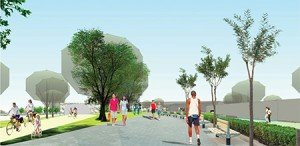 The proposal while offering a dynamic and engaging public destination does not require land acquisition. The areas considered are only the ones above the current railway tracks. The cost of construction would be approximately equivalent to that of an 114km long, six lane flyover. Instead of a bituminous or concrete surface, it would have a landscaped surface, totally traffic & stress-free. Further, it being a high transit urban linear park, retail along the Greenway will help keep it financially positive.
The proposal while offering a dynamic and engaging public destination does not require land acquisition. The areas considered are only the ones above the current railway tracks. The cost of construction would be approximately equivalent to that of an 114km long, six lane flyover. Instead of a bituminous or concrete surface, it would have a landscaped surface, totally traffic & stress-free. Further, it being a high transit urban linear park, retail along the Greenway will help keep it financially positive.
The estimated construction period from design finalisation to project completion is seven to eight years undertaken in stages and delivered progressively from South to North. Proper project management and scheduling of work when services do not run would ensure little or no disruption in either the existing train schedule or road network. On-site work would only involve assembly and final finishing involving precast concrete and/or steel, prepared off-site.
Environmental Sustainability
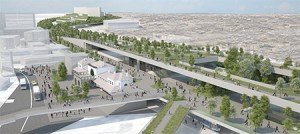 The greenway is a completely self-sustainable model that will improve infrastructure and integrate urban parks into living, working and commuting spaces. Unlike most infrastructure projects in Bombay (flyovers, freeways, skywalks, etc.), the Greenway would be self-sustainable and carbon neutral with a positive impact on the ecosystem.
The greenway is a completely self-sustainable model that will improve infrastructure and integrate urban parks into living, working and commuting spaces. Unlike most infrastructure projects in Bombay (flyovers, freeways, skywalks, etc.), the Greenway would be self-sustainable and carbon neutral with a positive impact on the ecosystem.
Environmental sustainable features: Inherent to the design are features like water conservation and re-use, on-site energy production, smart technology for control of lighting, shading, and solar power. Introducing indigenous trees on the Greenway will enhance local biodiversity and help in reducing carbon footprint.
Water harvesting potential: The project offers minimum 917 acres green space with a potential water harvesting capacity of 740 crore litres. This would be enough not only to keep the project self-sustainable, but also to feed neighbouring areas with sufficient water for the whole year.
Benefit to city rail transport
An upgraded railway station that doubles up as an urban park will greatly improve the daily commute by train, providing upgraded facilities to accommodate the predicted increase in passengers.
• Newly created retail spaces cafés, restaurants, shops will be revenue generators
• Railway crossing accidents would be reduced
• Rainwater lost yearly will be harvested and incidents of flooding controlled.
• The existing overhead equipment can be laid under the Greenway, eliminating accidents that are currently common
• Sound pollution due to the trains is better contained & dramatically reduced
• Heat gain on the trains will be reduced, allowing for more effective & economical air-conditioning
• These dedicated corridors would significantly improve access to stations and pedestrian comfort
 TrafficInfraTech Magazine Linking People Places & Progress
TrafficInfraTech Magazine Linking People Places & Progress
